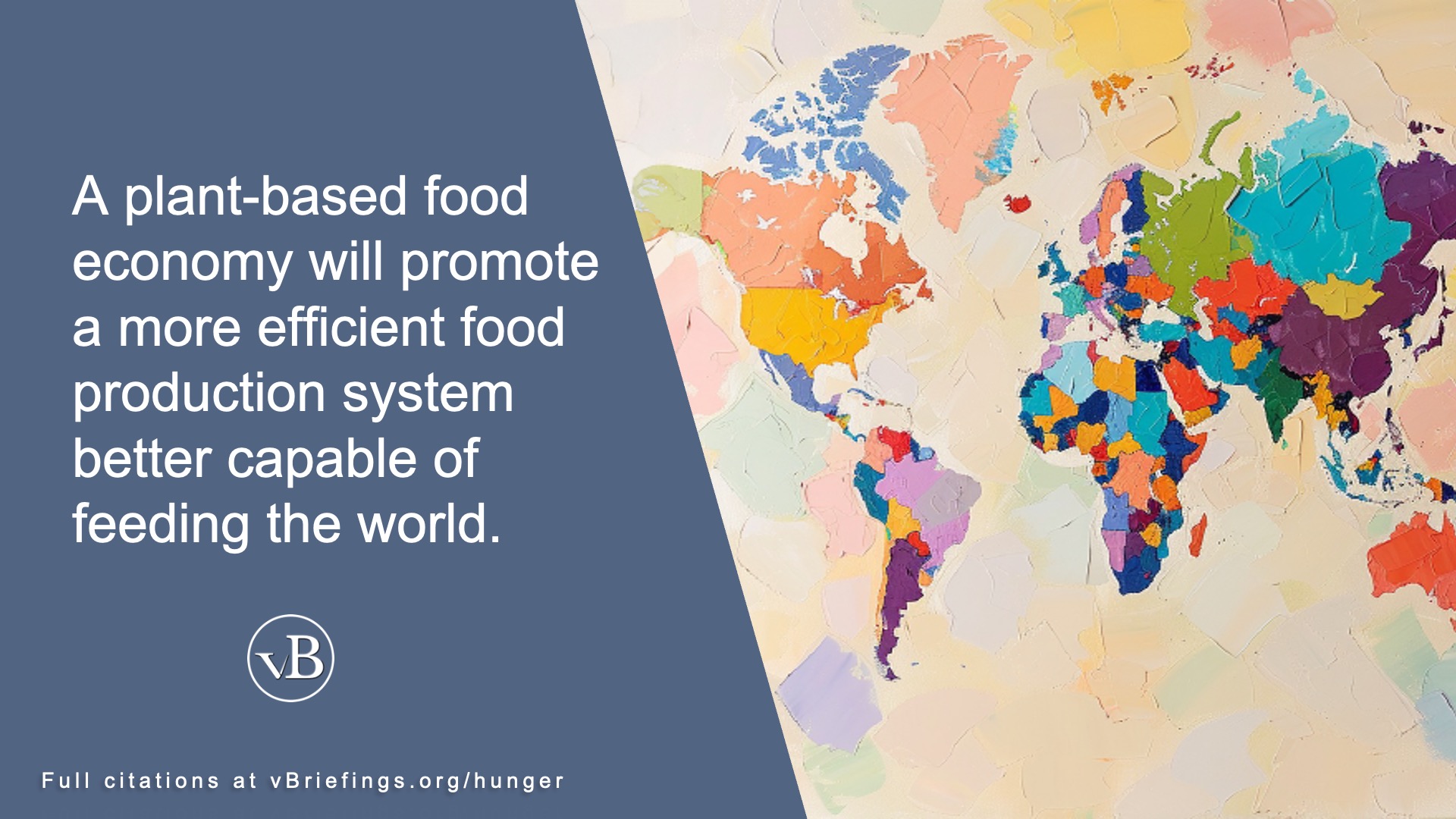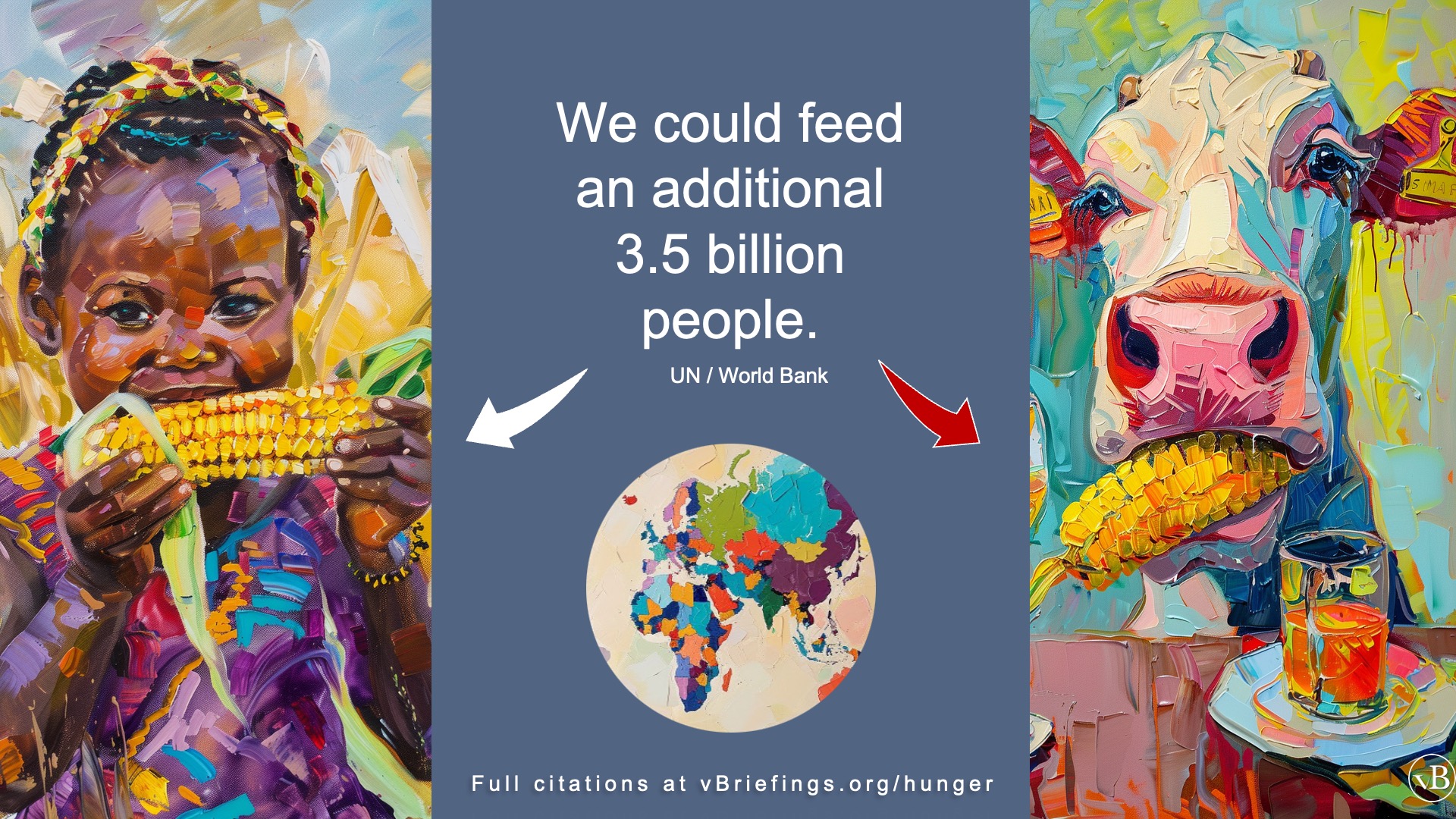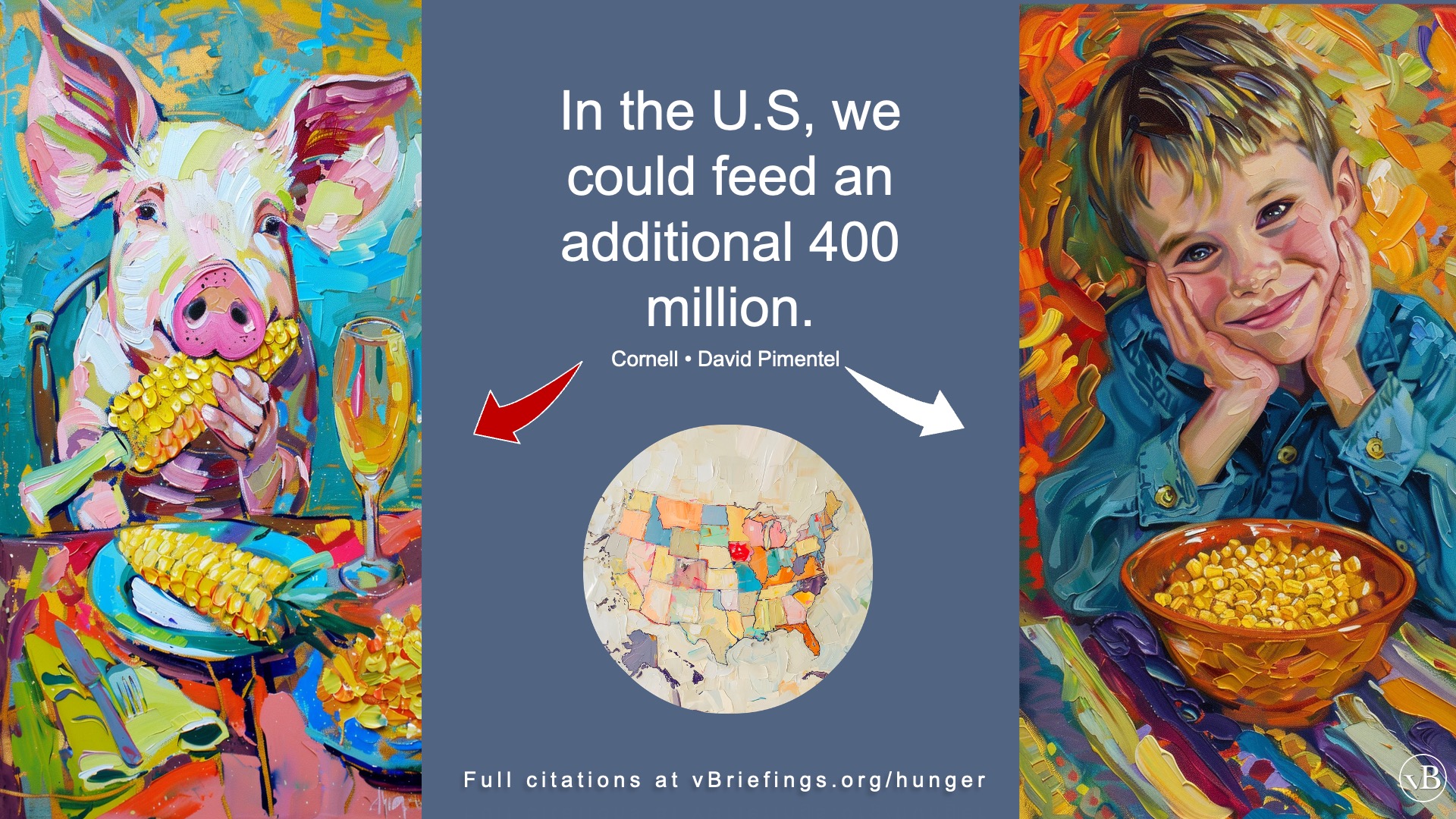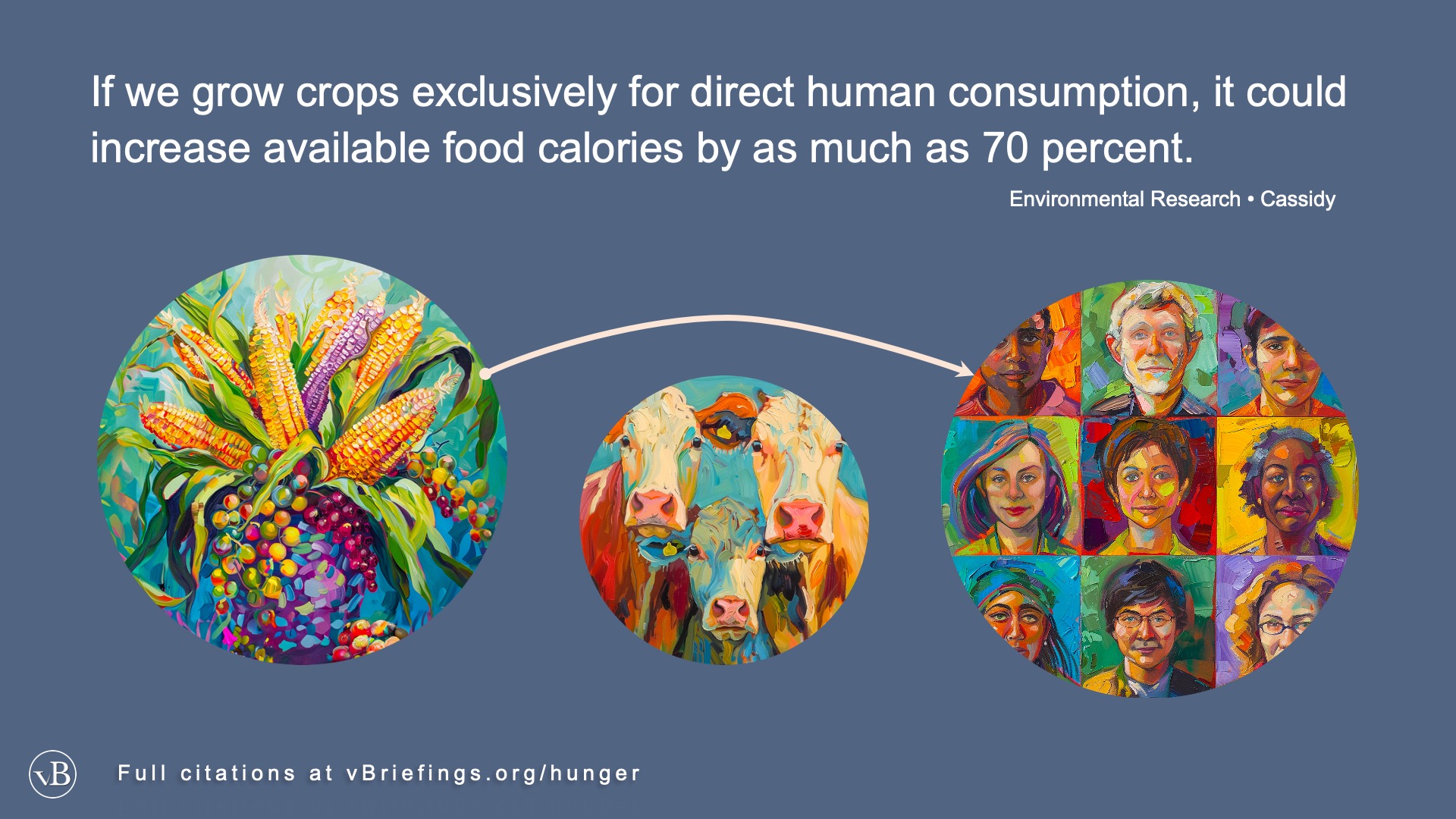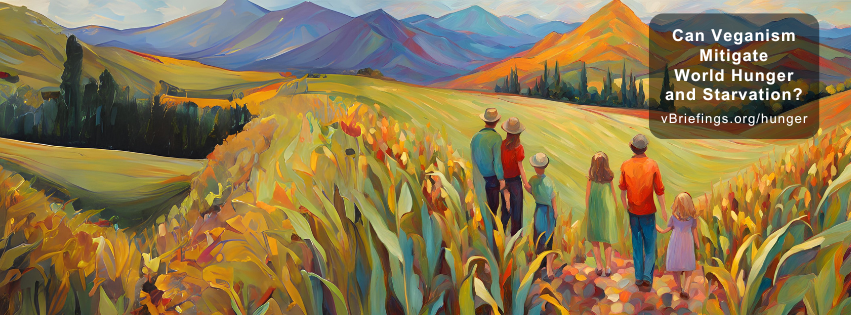Preface
Briefing description and more.
A plant-based food economy will promote a more efficient food production system better capable of feeding the world.
Companion Videos
How to use companion videos
Videos may be posted on multiple social media platforms, and you can share them on each platform according each platform’s conventions.
Share this Briefing
Social Media Sharing Image
This image will be used when sharing the briefing on a social media platform. You can see all social sharing images in the grid view.
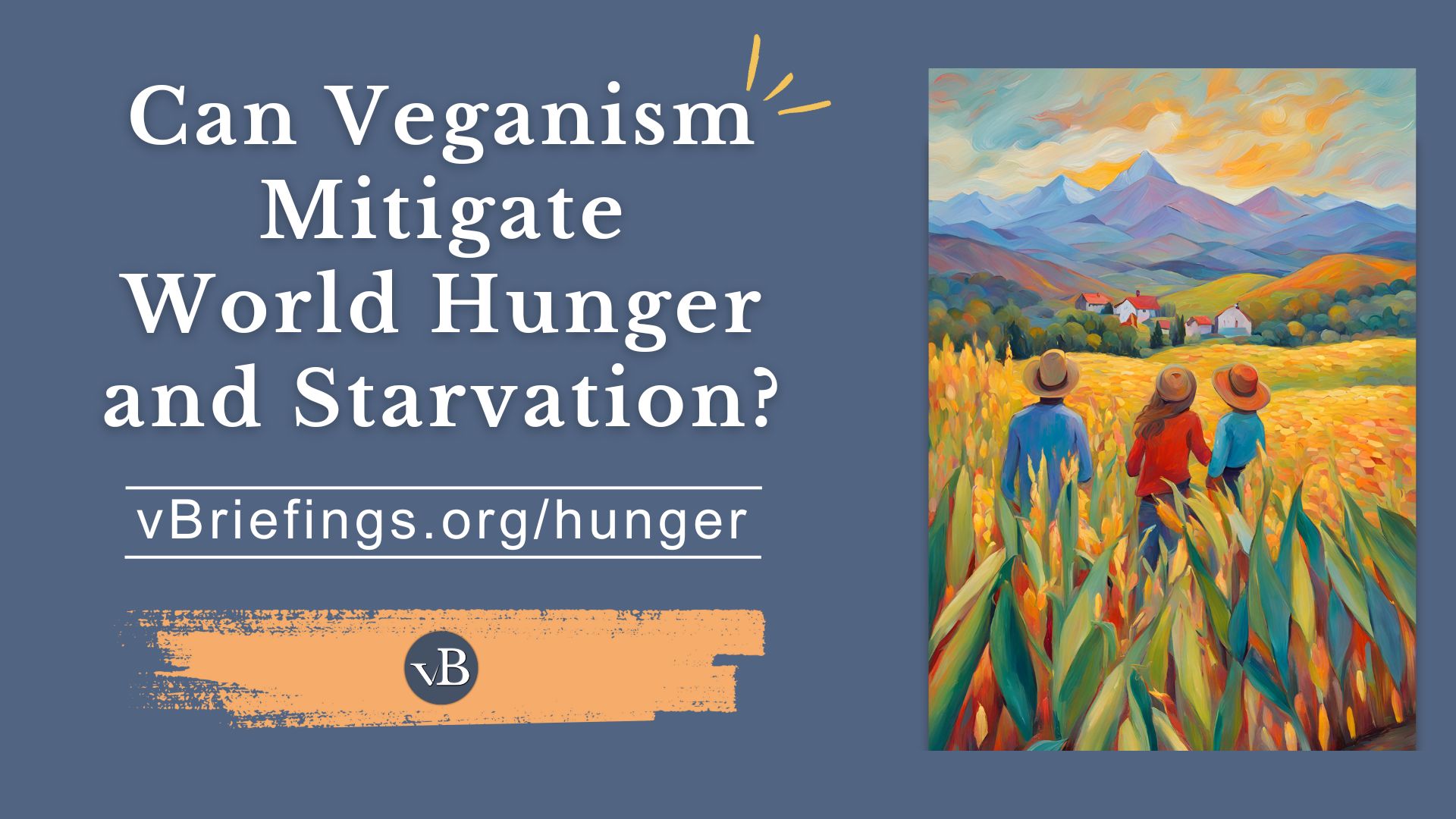
How to share this briefing
Click on the icon for the platform on which you wish to share. What happens next depends on the platform, but generally a popup will appear, letting you add your own text as you share.
Briefing Meta
Metrics
Note: we will publish additional briefings after completing flashcards and presentation slides for selected briefings.
Counts:
| Main Text | |
| Key Points | 5 |
| Counterclaims | 5 |
| Supplementary | 2 |
| Further Study | 5 |
| Footnotes | 45 |
| Media & Advocacy | |
| Advocacy Notes | 9 |
| —Socratic Questions | 9 |
| Flashcards | 61 |
| Presentation Slides | 27 |
| Memes & Infographics | 4 |
| Companion Videos | 1 |
Other Meta:
Date Posted:
Last Edited:
Edit Log:
Key Points Links
Loading…
Help Us Improve
Please send your suggestions for improvements, or report any issues with this briefing to team@vbriefings.org
We appreciate that you are taking the time to help up improve. All suggestions and reports will be carefully considered.
Summary
A concise summary of the briefing (see below for citations).
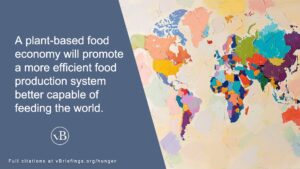
Over 75% of the world’s soy and grain is fed to farmed animals, despite the inefficiency of this process, as it takes 24 calories of feed to produce one calorie of human food. Most feed calories are used for the animals’ daily living rather than producing flesh, dairy, or eggs. Research suggests that if these crops were fed directly to humans, it could feed 3.5 billion more people globally and 460 million more in the United States, highlighting the potential of a plant-based food economy to address world hunger and starvation.
Context
Places this topic in its larger context.
Globally, over 9 million people including 3 million children die from starvation every year (UN World Food Program).12
Globally, more than 700 million people,3 including over 350 million children, face hunger along with the challenges of undernourishment or malnutrition. (UN World Food Program).4
With the human population projected to rise from 8.2 billion in 2024 to 10.3 billion by the 2080s5, food production will need to increase by about 25% to keep pace.
While we do produce enough to feed everyone, hunger and starvation are complex problems involving logistics, food waste, war, extreme weather, poverty, food production systems, and pandemics (Bloomberg Analysis 6; UN World Food Program7).
Details
Poor logistics prevent food from getting to those in need in a timely manner.
Food Waste: food gets spoiled or discarded, reducing what’s available for consumption.
War disrupts production, displaces people from food sources, and it can also create trade blockages.
Extreme weather such as droughts, floods, hurricanes, and tornadoes, exacerbated by climate change, devastates crops and reduces harvests.
Poverty limits people’s ability to afford food, even when it’s available.
Pandemics disrupt food production and supply chains, and strain social support systems.
Food production systems are where the difference in efficiency between plant-based food production and animal agriculture plays out, and is the focus of this briefing.
Key Points
This section provides talking points.
Multiple studies show that we can feed far more people on a plant-based, vegan diet.
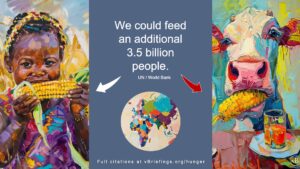
“The calories that are lost by feeding cereals to animals, instead of using them directly as human food, could theoretically feed an extra 3.5 billion people.” (A research report from the United Nations Environment Program, the World Bank, and others, and signed by 58 nations (UNEP IAASTD report).8
- Don’t let the word theoretically throw you—of course it’s theoretical because it would be impossible to conduct an experiment to test this. The conclusion is based on modeling and analysis.
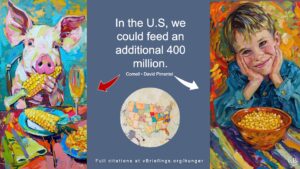
“If all the grain currently fed to livestock in the United States were consumed directly by people, the number of people who could be fed would be nearly 800 million.” (An analysis by a Cornell University ecologist David Pimentel).9 This is about 460 million more than 338 million, the 2023 population of the United States (Census Bureau).10
- To put this in context the study also notes that “Each year an estimated 41 million tons of plant protein is fed to U.S. livestock to produce an estimated 7 million tons of animal protein for human consumption. About 26 million tons of the livestock feed comes from grains and 15 million tons from forage crops.”11
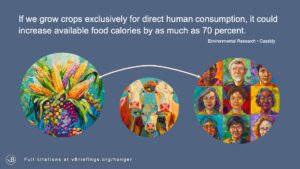
“Given the current mix of crop uses, growing food exclusively for direct human consumption could, in principle, increase available food calories by as much as 70%, which could feed an additional 4 billion people.”(Environmental Research Letters).12
By replacing animal products in our diet with plant-based alternatives, we can produce up to 20 times more nutritionally similar food with the same amount of land. The gain varies from 2 to 20 times depending on the animal (PNAS, by two environmental scientists, a physicist, and a molecular biologist).13
Over 75% of the world’s grains and soy used for food are fed to animals.
According to the UN’s 2022 Food Outlook report, approximately 75% of the world’s coarse grains used for food are fed to animals. Coarse grains include corn, oats, barley, sorghum, millet, and rye.14
According to a 2021 report compiled by the Our World in Data group from the UN and other sources, “More than three-quarters (77%) of global soy is fed to livestock for meat and dairy production.”15
Most of the grains and soy used for animal feed could provide good nutrition to humans.
Coarse grains are not just edible by humans but also contain nutrients important for maintaining human health (A PubMed Study).16
Field corn (as opposed to sweet corn) is sometimes mistakenly thought of as used only for animal feed, yet can provide human nutrition. Maize, which is essentially field corn, is eaten by humans in several cultures(Michigan State Extension17; New York Academy of Sciences18 ).
The soybeans used for animal feed are largely the same as those used for human consumption, but they are processed differently (IntechOpen report).19
The reason we can feed far more on a vegan diet is because animal agriculture is extremely inefficient.
Animal agriculture is so inefficient because most of the feed calories consumed by an animal go toward energy for daily living. Also, some energy is expended to produce body parts that are not consumed (Applied Animal Nutrition Journal).20
Animal agriculture uses 83% of global farmland while producing only 18% of total calories and 37% of protein. This is according to a 2018 J Poor-led study from Oxford which has been called “the most comprehensive analysis to date of the damage farming does to the planet,” having examined 38,700 farms in 119 countries representing 90% of the world’s protein and calorie consumption.(The Guardian21; “Reducing food’s environmental impacts through producers and consumers”, published in Science Magazine22).
- The logical converse of this startling statistic is that 17% of farmland is used to grow food for human consumption, yet produces 82% of total calories and 63% of calories from protein.
Calorie conversion: It takes on average 24 calories of plant feed to produce one calorie of food from animals.(World Resources Institute, “Creating a Sustainable Food Future”23).
Feed conversion: It takes on average 4 to 6 pounds of feed to produce one pound of food made from farm animals.24
- Even with the dismal feed conversion ratio of 5 to 1, such a ratio understates the inefficiency because it “improperly compares the weight of a relatively wet output (meat) to the weight of a relatively dry input (feed grains)” (World Resources Institute, “Creating a Sustainable Food Future”).25
According to a University of Minnesota study, only 12% of crops fed to animals contribute to the human diet as meat and other animal products.26
Many countries export grain, or provide food for animals destined to be eaten by the more affluent, while their own children are starving or hungry.
Phillip Wollen, a philanthropist and a former Vice-President of Citibank, said, “As I travel around the world, I see poor countries sell their grain to the West while their own children starve in their arms.”27
“Tragically, some 80% of the world’s hungry children live in countries with actual food surpluses, much of which is in the form of feed fed to animals which will be consumed by only the well-to-do consumers” (Jeremy Rifkin, noted author of 23 books on the impact of global changes).28
“…82% of the world’s starving children live in countries where food is fed to animals that are then killed and eaten by more well-off individuals in developed countries like the US, UK, and in Europe” (Dr. Richard Oppenlander, 2012 Book).29
It seems almost criminal that starving and hungry people, be they children or adults, do not have access to food grown locally—food that is instead used to support the animal agriculture industry.
Counterclaims
Responses to some yes but retorts.
Claim: We already produce enough food to feed everyone—hunger and starvation are logistical and food waste problems.
Yes, we are producing enough to feed everyone (Bloomberg Analysis).30
Logistics and food waste do indeed contribute to hunger and starvation problems, as do war, extreme weather, extreme poverty, and pandemics (UN World Food Program).31
Still, it seems naïve to think that the ability to feed an additional 3.5 billion globally and an additional 460 million in the United States would not help with the problem because some of that additional food would likely reach the hungry and starving (United Nations Environment Program32; an analysis by a Cornell University ecologist David Pimentel33).
The expected rise human population from 8.2 billion in 2024 to 10.3 billion by the 2080s34 suggests we might not be able to feed everyone forever.
The benefits of transitioning from animal-based to plant-based food sources substantially exceed the potential gains from eliminating all supply chain food waste, according to an assessment of opportunity costs (A study published in the Proceedings of the National Academy of Sciences by two environmental scientists, a physicist, and a molecular biologist).35
There will likely be less waste with plant-based foods, particularly grains, nuts and seeds, because they can be stored longer before spoilage compared to meat, dairy, and eggs, and refrigeration is less important.
Claim: “86% of the global livestock feed intake is made of materials that are inedible by humans.”
A Sacred Cow article misquoted a Science Direct analysis when it said that “86% of the global livestock feed intake is made of materials that are inedible by humans.”36
The Science Direct analysis, in the body of the paper, instead says, “…86% is made of materials that are currently not eaten by humans,” not materials that humans cannot eat.37
- The person who summarized the paper also misquoted the text in the body of the paper.
- The distinction between materials that are “not eaten by humans” and those that are inherently “inedible” is important in understanding the implications of the 86% figure. If the calculation were based on the inherent edibility of feed materials, the percentage of non-edible feed could differ significantly from the 86% figure.
Even the misquoted Science Direct analysis refers to “the relatively low efficiency of animals in converting feed into human-edible products (Ibid).”
The Science Direct analysis is based on feed weight, not calories (Ibid).
- If the analysis was by calories, the 86% figure would be considerably lower as the non-edible portion of animal feed is typically composed of materials such as crop residues, food waste, and by-products from food processing, which are generally lower in caloric content compared to edible feed sources such as grains and legumes.
This 86% claim, even if true, would not change the fact that over 75% of the world’s grains and soy used for food are fed to animals, as shown above.
This 86% claim, even if true, would not change the research reported above showing that with plant-based foods we could feed an additional 3.5 billion globally and another ~460 million in the US (as referenced earlier), and that livestock are highly inefficient at converting feed into meat.
This 86% claim, even if true, fails to consider that much of the land used to grow silage and fodder crops (such as corn, barley, and alfalfa) for feed could also be used to grow crops for human consumption.38
This 86% claim, even if true, would not change the research referenced above, showing that it takes on average 24 calories of plant feed to produce one calorie of food from animals.
Claim: Increased grazing, particularly holistic, regenerative grazing, can help with the problem because grazed animals do not require feed.
We simply don’t have enough land—the US has enough pasture to support only 27% of the current beef production (Environmental Research Letters 2018).39
Grazed animals are often fed grains even while grazing and then moved to a feedlot to be fed grains for 4 to 6 months of their 18-month (Food Transparency Project, 2020)40) existence before being slaughtered (The North American Meat Institute, 2015).41
Claim: Because there are starving people, we should put them first over non-human animals.
We address this related tangential claim here because it is sometimes posited as a general objection to veganism, not an objection to the premise of this briefing.
As we have documented in this briefing, you can feed far more with a plant-based food economy, so this point is moot.
Even if you could not feed more people with plants, it’s possible to care about and act on more than one problem.
Claim: It would be impossible or difficult for people in some cultures to give up animal products because of a lack of alternatives.
We address this related tangential claim here because it is sometimes posited as a general objection to veganism, not an objection to the premise of this briefing.
This is true, but irrelevant to most of the people reading this who are not in a food desert and within easy reach of multiple grocery stores.
It would be disingenuous for someone to proclaim, for example, that because goat herders in Afghanistan can’t do it, they are not even going to consider it.
Supplementary Info
Additional information that may prove useful.
“While Asia currently has the greatest number of undernourished (381 million), people, the report showed that the number in Africa is growing fast (250 million), followed by Latin America and the Caribbean (48 million)” (United Nations).42
“On current trends, by 2030, Africa will be home to more than half of the world’s chronically hungry” (United Nations, 2020).43
Further Study
Sources providing a deeper understanding of the topic or related topics.
Related Briefings
None Yet
Other Resources
The website A Well-Fed World provides research and analysis on how “a global shift towards plant-based foods more efficiently uses crops and natural resources to nourish people and cool the climate.”
Mic the Vegan’s YouTube video “A Solution to World Hunger?” provides “a look at some well-documented and major inefficiencies in the global food distribution that are driven by food choice, plus how to fix them.”
A multi-discipline report with recommendations for agriculture titled The IAASTD Report—Agriculture at a Crossroads is the work of the United Nations Environment Program.
The article 10 Facts About Child Hunger in The World by the UN World Food Program, will give you a better understanding of the impacts of hunger on children.
A research article The Opportunity Cost of Animal Based Diets Exceeds All Food Losses explores the opportunity cost of animal agriculture, and as such, indirectly addresses hunger.
Advocacy Resources
Information to help with outreach and advocacy.
Note: we will publish additional briefings after completing flashcards and presentation slides for selected briefings.
Share This Briefing
Cloned from the Preface Section on page load.
Companion Videos
Cloned from the Preface Section on page load.
Memes and Infographics
How to use Memes and Infographics
To sequence through all memes and infographics on this page, click on any image than use the arrow keys or the arrow buttons to show next and previous images.
To share a meme or infographic, right click on the image and choose download or save as. Then upload the image to the platform of choice.
Presentation Slides
How to Use the Presentation Slides
You can view the slideshow full screen by clicking on the first link above.
To use Canva presenter mode, view the speaker notes, or download the slides as PowerPoint, login to Canva (the free account works) and follow the Full Canva Link provided above.
To copy this presentation to your own Canva project, use the Full Canva Link provided above, then select File->Make a Copy from the upper left. You can build your own unique presentation from multiple briefings by copying the presentation from each briefing and then building another presentation from the copied presentations.
Flash Cards
We partner with Brainscape because of their excellent features for learning. You will need to create a free Brainscape account to study the cards.
Go to Flash Cards: This will take you to a list of decks.
About Flash Cards and Brainscape
Flash cards are here to help you commit important facts and concepts in this briefing to memory.
In Brainscape, there is one deck for each briefing. You can study more than one deck at a time. Brainscape uses spaced repetition to promote memory retention. It is “the secret to learning more while studying less.”
You can study using your browser, but Brainscape also has a free mobile app that makes learning anywhere easy.
Socratic Questions
Socratic-style questions are embedded in the Advocacy Notes below, and shown in italics.
These are open-ended, thought-provoking questions designed to encourage critical thinking, self-reflection, and deeper understanding. They are inspired by the Socratic method, a teaching technique attributed to the ancient Greek philosopher Socrates, who would ask his students probing questions rather than directly providing answers.
The goal is to help people examine their beliefs, clarify their thoughts, uncover assumptions, and explore the evidence and reasoning behind their ideas.
Advocacy Notes
Tips for Advocacy and Outreach
General Tips
Don’t say that animal agriculture causes hunger and starvation but that “veganism promotes a more efficient food system better capable of feeding the world’s starving, hungry, and impoverished” or “the opportunity cost of animal agriculture contributes to hunger and starvation.”
When discussing this topic, it’s likely the interlocutor will bring up the first counterclaim addressed on this page—that we already produce enough to feed everyone. So it would be a good idea to familiarize yourself with our suggested response.
Remember that when discussing this topic you don’t have to remember all the points made here and the exact source for them. You can always refer your interlocutor to this page.
Segue the Conversation Back to Animal Ethics
You can pivot the conversation back to animal ethics by skillfully asking questions that show the relationship between hunger and animal ethics.
- “We talk a lot about people suffering from hunger, and rightfully so. But there are also billions of animals suffering in factory farms—terrified, confined, and ultimately slaughtered. Why not choose a diet that helps both?”
- “If we can feed more people on a plant-based diet and reduce suffering at the same time, why wouldn’t we? And since we don’t need to eat animals, what ethical justification is there for doing so?”
- “It’s tragic that so much food is wasted by feeding animals in factory farms. But beyond the inefficiency, we have to ask—what justifies slaughtering billions of animals when we don’t have to?”
Why? This keeps the focus on ethics instead of letting them use this argument as a distraction.
Shift the Focus from Distribution to Production
People might say, “Hunger isn’t caused by lack of food; it’s a distribution issue.” While that’s partially true, animal agriculture makes distribution worse, not better.
- “You’re right—hunger is about access, not just production. But why are we funneling food through animals first when that makes access even harder?”
- “Even if we fixed all distribution problems, we’d still be wasting huge amounts of food by cycling it through animals first. Shouldn’t we address both issues at once?”
Why? This prevents the person from dismissing the issue by shifting blame elsewhere.
Show the Inequity in Food Production and Distribution
People often don’t realize that poor countries export food to wealthier nations while their own people go hungry.
- “Did you know that some of the poorest countries grow food for wealthier nations’ livestock instead of feeding their own people?”
- “82% of starving children live in countries where food is being grown to feed animals for wealthier consumers. Does that seem fair to you?”
Why? This makes them feel the injustice rather than just hearing numbers.
Address the “But Not Everyone Can Go Vegan” Argument
Some people will say, “Not everyone can be vegan, especially in poorer countries.” While true, this doesn’t justify inaction for those who have a choice.
- That’s true—but does that mean those of us with easy access to plant foods shouldn’t make better choices?”
Why? This defuses the excuse while reaffirming the ethical stance.
Challenge the Idea That Food Grown for Animals Can’t Be Eaten By Humans
Many believe that crops grown for animal feed aren’t suitable for humans—but this is misleading.
- “Most of the grains fed to animals—corn, soy, oats—could feed people. If we used that land to grow food for humans instead, wouldn’t that help?”
- “If 24 calories of plant feed give us only 1 calorie of meat, how does that help feed a growing world?”
Why? This forces them to rethink efficiency rather than assuming animal agriculture is necessary.
How this topic is relevant to Animal Rights and Veganism
It is not unusual for someone to dismiss veganism by stating that as long as there are starving people, we should put them first over non-human animals.
The ability of veganism to have a positive impact on world hunger is often overlooked as one of the merits of veganism, yet perhaps should be included alongside animal ethics, the environment, and other public and personal human health issues.
Some industry sources4445 have at least implied that animal agriculture is necessary for producing enough food for everyone, yet the evidence as shown herein contradicts this notion.
Footnotes
Our sources, with links back to where they are used.
- 10 Facts About Child Hunger in The World. UN World Food Program, July 2022 ↩︎
- In a world of wealth, 9 million people die every year from hunger. UN World Food Program, September 2021 ↩︎
- Shyam Bishen, and World Economic Forum. “733 Million Faced Hunger Last Year, and Other Health Stories to Read.” World Economic Forum, 31 July 2024. Accessed 26 Dec. 2024. ↩︎
- 10 Facts About Child Hunger in The World. UN World Food Program, July 2022 ↩︎
- LEDERER, EDITH M. “World Population Projected to Grow to 10.3 Billion in 2080s, UN Says.” AP News, 11 July 2024, Accessed 26 Dec. 2024. ↩︎
- Without Clearing Any New Farmland, We Could Feed Two Earths’ Worth of People, Bloomberg (analysis), December 15, 2020 ↩︎
- “6 Causes of World Hunger – Why There Is Global Food Insecurity.” UN World Food Program ↩︎
- “The IAASTD Report—Agriculture at a Crossroads.” United Nations Environment Program, 2008. ↩︎
- “U.S. Could Feed 800 Million People with Grain That Livestock Eat, Cornell Ecologist Advises Animal Scientists.” Cornell Chronicle, February 5, 2022. ↩︎
- “Population Clock.” Archive.org, 2023, web.archive.org/web/20231201232905/www.census.gov/popclock/. Accessed 5 Dec. 2023. ↩︎
- “U.S. Could Feed 800 Million People with Grain That Livestock Eat, Cornell Ecologist Advises Animal Scientists.” Cornell Chronicle, February 5, 2022. ↩︎
- Redefining agricultural yields: from tonnes to people nourished per hectare, Environmental Research Letters, 2013 ↩︎
- Shepon, Alon, Gidon Eshel, Elad Noor, and Ron Milo. “The Opportunity Cost of Animal Based Diets Exceeds All Food Losses.” Proceedings of the National Academy of Sciences 115, no. 15 (April 10, 2018): 3804–9. ↩︎
- In the referenced report, under Markets at a Glance—Course Grains, the latest data shows 224.7 units of coarse grains were used for human food (food) and 864.3 units were used for animal food (feed). Therefore, a total of 1089 units in total were used for food, but 864.3 of those were fed to animals. This is over 79% of the total. Food Outlook. United Nations FAO. November 2022. ↩︎
- Soy, Our World in Data. Hannah Ritchie and Max Roser. 2020 ↩︎
- Yao ZD, Cao YN, Peng LX, Yan ZY, Zhao G. Coarse Cereals and Legume Grains Exert Beneficial Effects through Their Interaction with Gut Microbiota: A Review. J Agric Food Chem. 2021 Jan 27;69(3):861-877. doi: 10.1021/acs.jafc.0c05691. Epub 2020 Dec 2. PMID: 33264009. ↩︎
- Sweet corn and field corn, what are the differences?, Michigan State University Extension, 2013. ↩︎
- Global Maize Production, Utilization, and Consumption, NY Academy of Sciences, 2015. ↩︎
- Soybean for Human Consumption and Animal Feed, IntechOpen Online Report, 2021 ↩︎
- James Rowe and John Nolan, Energy Requirements of Livestock. The Theory and Practice of Animal Nutrition, Applied Animal Nutrition Journal 2009 ↩︎
- Carrington, Damian, and Damian Carrington Environment editor. “Avoiding Meat and Dairy Is ‘Single Biggest Way’ to Reduce Your Impact on Earth.” The Guardian, May 31, 2018, sec. Environment ↩︎
- Poore, J., and T. Nemecek. “Reducing Food’s Environmental Impacts through Producers and Consumers.” Science 360, no. 6392 (June 2018): 987–92. ↩︎
- The 24 to 1 figure was calculated from the table on page 37, figure 12, by averaging the ratios of calories in to calories out among the different animal products. For example, pigs consume 10 calories to get one calorie of pork out (100/10). If you average beef (100), milk (14), shrimp (14), pork (10), chicken (9), fin fish (8), and egg (13), you get 24. If sheep and buffalo milk were included, the average would be even more concerning. “Creating a Sustainable Food Future.” World Resources Institute, 2013-2014. ↩︎
- The 4-6 figure was taken by averaging the highs and low of the three most eaten farm animals, cows, pigs, and chickens, from this report: Farmbrite. “Feed Conversion Ratio Calculator.” Farmbrite, 5 Jan. 2023, www.farmbrite.com/post/feed-conversion-ratio-calculator. Accessed 15 Dec. 2024. ↩︎
- “Creating a Sustainable Food Future: Interim Findings | World Resources Institute.” December 2, 2013. 36. ↩︎
- “Redefining Agricultural Yields: From Tonnes to People Nourished per Hectare – IOPscience,” August 13, 2013. ↩︎
- Philip Wollen : Animals Should Be Off The Menu, May 16, 2012. ↩︎
- Jeremy Rifkin. The World’s Problems on a Plate. The Guardian. 2002. ↩︎
- Dr. Richard Oppenlander. “Comfortably Unaware :: The World Hunger-Food Choice Connection: A Summary,” April 22, 2012. ↩︎
- Without Clearing Any New Farmland, We Could Feed Two Earths’ Worth of People, Bloomberg (analysis), December 15, 2020 ↩︎
- “6 Causes of World Hunger – Why There Is Global Food Insecurity.” UN World Food Program ↩︎
- “The IAASTD Report—Agriculture at a Crossroads.” United Nations Environment Program, 2008. ↩︎
- “U.S. Could Feed 800 Million People with Grain That Livestock Eat, Cornell Ecologist Advises Animal Scientists.” Cornell Chronicle, February 5, 2022. ↩︎
- LEDERER, EDITH M. “World Population Projected to Grow to 10.3 Billion in 2080s, UN Says.” AP News, 11 July 2024, Accessed 26 Dec. 2024. ↩︎
- Shepon, Alon, Gidon Eshel, Elad Noor, and Ron Milo. “The Opportunity Cost of Animal Based Diets Exceeds All Food Losses.” Proceedings of the National Academy of Sciences 115, no. 15 (April 10, 2018): 3804–9. ↩︎
- Sacred Cow. “Only a Small % of What Cattle Eat Is Grain. 86% Comes from Materials Humans Don’t Eat.,” September 10, 2019. ↩︎
- Anne Mottet, Cees de Haan, Alessandra Falcucci, Giuseppe Tempio, Carolyn Opio, Pierre Gerber, Livestock: On our plates or eating at our table? A new analysis of the feed/food debate, Global Food Security, Volume 14, 2017, Pages 1-8, ISSN 2211-9124. ↩︎
- Comparison of Farming in Production of Food Per Acre, Humane Party Analysis using USDA and UN FAO data ↩︎
- Hayek, Matthew N, and Rachael D Garrett. “Nationwide Shift to Grass-Fed Beef Requires Larger Cattle Population.” Environmental Research Letters 13, no. 8 (July 25, 2018): 084005. ↩︎
- “Age of Animals Slaughtered.” Farm Transparency Project, November 11, 2020. ↩︎
- “Corn-Fed Versus Grass-Fed Beef Fact Sheet.” North American Meat Institute, January 2015. ↩︎
- UN report sends ‘sobering message’ of deeply entrenched hunger globally. UN News. July 13, 2020. ↩︎
- UN report sends ‘sobering message’ of deeply entrenched hunger globally. UN News. July 13, 2020. ↩︎
- “The Value and Importance of Animal Agriculture. Dairy Business Magazine. June 12, 2020. ↩︎
- Lawrence P Reynolds, Meghan C Wulster-Radcliffe, Debra K Aaron, Teresa A Davis, Importance of Animals in Agricultural Sustainability and Food Security, The Journal of Nutrition, Volume 145, Issue 7, July 2015, Pages 1377–1379 ↩︎




